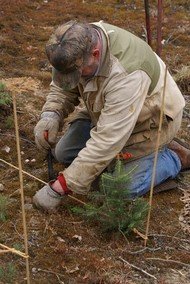Eco-Friendly Christmas Trees
Environmental Benefits of Real Christmas Trees:
While they're growing, Real Christmas Trees support life by absorbing carbon dioxide and other gases and emitting fresh oxygen.
The farms that grow Christmas Trees stabilize soil, protect water supplies and provide refuge for wildlife while creating scenic green belts. Often, Christmas Trees are grown on soil that doesn't support other crops.
After several years of harvesting trees from a certain field, it is common for a farmer to let the remaining trees grow into a mature forest.
What About Fake Trees?
Fake Trees are a petroleum-based product (PVC) manufactured primarily in Chinese factories. The manufacture of PVC creates and disperses dioxins, which include the most toxic man-made chemical known. Released into air or water, dioxins enter the food chain, where they accumulate in fatty tissues of animals and humans, a potential risk for causing cancer, damaging immune functions and impairing children's development.
Real Christmas Trees Are Renewable (Fake Trees Are Not)
Real Christmas Trees are grown on farms just like any other crop. To ensure a constant supply, Christmas Tree growers plant one to three new seedlings for every tree they harvest. Additionally, Real Christmas Trees are biodegradable, which means they can be easily reused or recycled for mulch and other purposes.
On the other hand, the average family uses an artificial tree for only six to nine years before throwing it away, where it will remain in a landfill for centuries after disposal.
Remember: Real Christmas Trees do not come from forests. They are planted on farms for the specific purpose of being harvested as Christmas trees.



